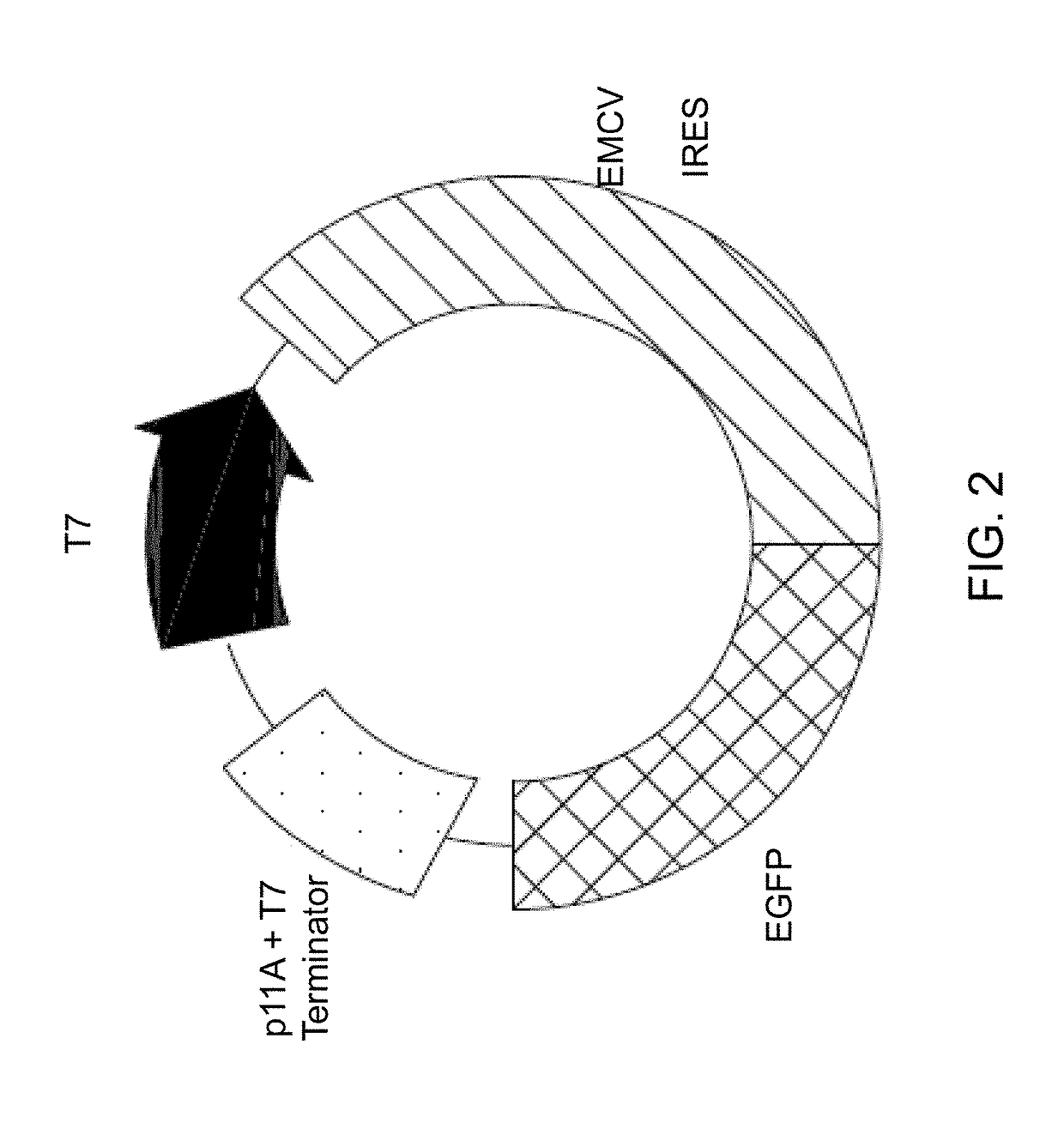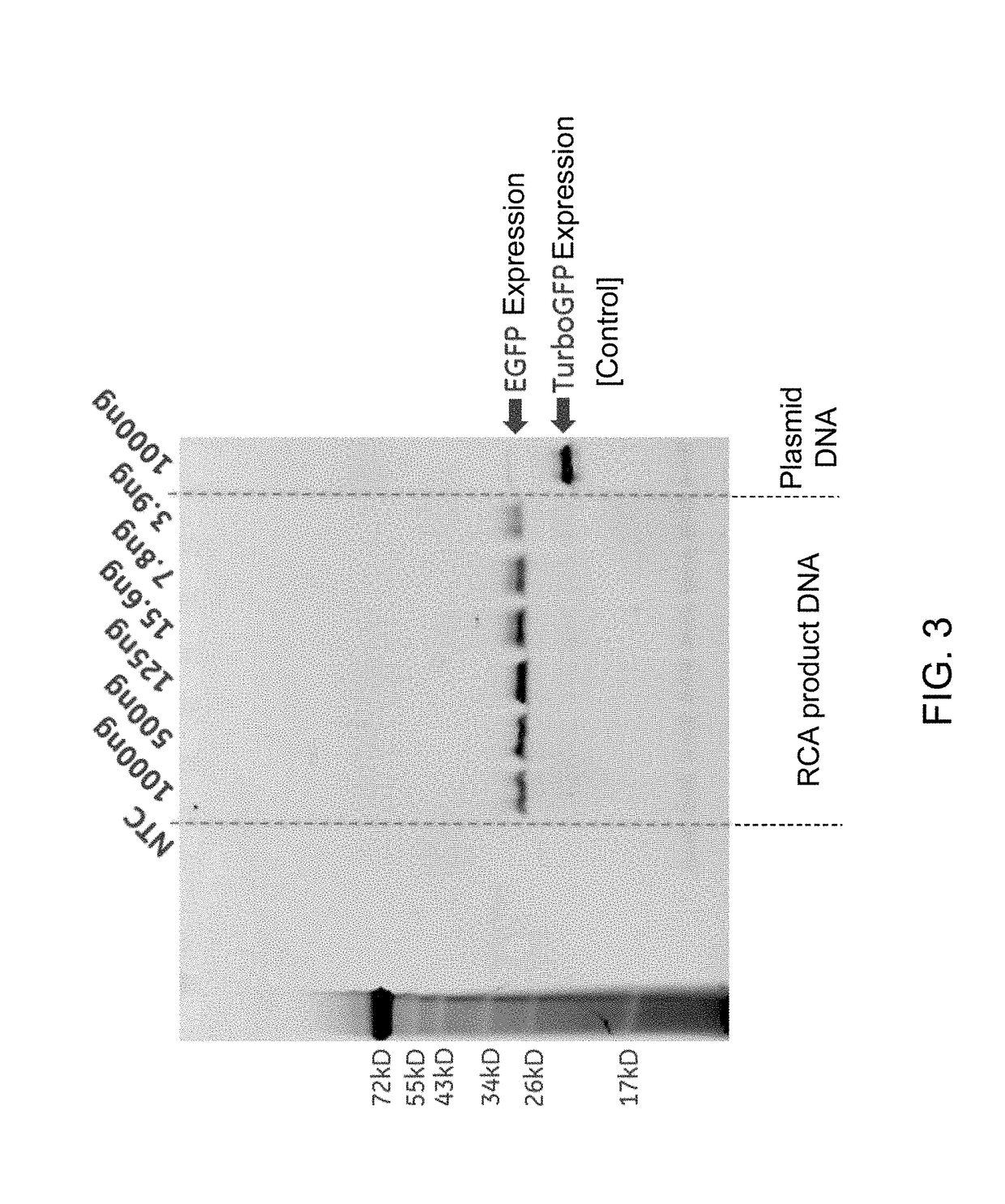Cell-free protein expression using double-stranded concatameric DNA
a cell-free protein and concatameric technology, applied in the field of cell-free protein expression systems, can solve the problems of insufficient amount of dna templates, large quantity (generally in microgram quantities), and inability to obtain sufficient amounts of such dna templates
- Summary
- Abstract
- Description
- Claims
- Application Information
AI Technical Summary
Benefits of technology
Problems solved by technology
Method used
Image
Examples
example 1
Generation of a RCA Product DNA
[0075]The RCA product DNA was generated either from a circular DNA template (either a plasmid positive control e.g., pCFE-GFP, or from a DNA mini-circle having minimalistic expression sequence) by an RCA reaction. The plasmid positive control, pCFE-GFP, was purchased as part of the 1-Step Human Coupled IVT kit. This purified plasmid comprises an internal ribosomal entry sites (IRES) of encephelomyocarditis virus (EMCV) and encodes TurboGFP protein.
Generation of a DNA Mini-Circle:
[0076]Minimalistic expression sequences for EGFP were designed in silico and synthesized in vitro. The minimalistic expression sequences primarily contained a T7 promoter and +1 sequence (first ribose position of the 5′-untranslated region of the resulting mRNA) followed by an IRES sequence fused to the EGFP coding region. A variety of additional non-coding and coding parameters were included during the designing of the minimalistic expression sequence, including T7 pre-promote...
example 2
Expression of the RCA Product DNA Generated from a Plasmid DNA in a Eukaryotic Cell-Free Extract
[0082]1-Step Human Coupled IVT kit includes a pCFE-GFP as a positive control vector containing the internal ribosomal entry sites (IRES) of encephelomyocarditis virus (EMCV) and encoding a TurboGFP protein. As the RNA folding of IRES sequence is known to significantly affect the regulation of translation efficiency, the components within the 1-Step in vitro transcription translation (IVTT) kit have been optimized for EMCV IRES activity.
[0083]The pCFE-GFP control vector was amplified by RCA using AT primers (SEQ. ID. No.6) in the presence or absence of thioated dATP, as described in Example 1. In vitro transcription-translation assays using 1-Step Coupled IVT were performed per manufacturer instructions. One microgram of RCA product DNA, without any intermediate purification, was added to Hela-cell lysate (250 μL final volume) and was incubated at 30° C. for 6 hours in an Eppendorf ThermoM...
example 3
Cell-Free Protein Expression Using RCA Product DNA Generated from the DNA Mini-Circle
[0086]Data from Example 2 (FIG. 1) showed that when RCA product DNA was used as a template for IVTT assay using HeLa cell lysate, a 4 to 8-fold lower concentration of the RCA product DNA was required for optimal protein expression in comparison to the plasmid DNA. This observation was further established by using an RCA product DNA generated from a DNA mini-circle for IVTT reactions. The RCA product DNA generated from the DNA mini-circle template was prepared and utilized to compare protein expression by IVTT. A DNA sequence (SEQ ID No. 5) encoding an EGFP protein was ligated to form a mini-circle and amplified by RCA using AT primers in the presence of thioated dATP, as described in Example 1. The RCA product DNA was serially diluted to generate samples of the RCA product DNA with different concentrations. Different concentrations of the RCA product DNA were added to 25 μL of 1-Step Human Coupled I...
PUM
| Property | Measurement | Unit |
|---|---|---|
| concentration | aaaaa | aaaaa |
| concentration | aaaaa | aaaaa |
| concentration | aaaaa | aaaaa |
Abstract
Description
Claims
Application Information
 Login to View More
Login to View More - R&D
- Intellectual Property
- Life Sciences
- Materials
- Tech Scout
- Unparalleled Data Quality
- Higher Quality Content
- 60% Fewer Hallucinations
Browse by: Latest US Patents, China's latest patents, Technical Efficacy Thesaurus, Application Domain, Technology Topic, Popular Technical Reports.
© 2025 PatSnap. All rights reserved.Legal|Privacy policy|Modern Slavery Act Transparency Statement|Sitemap|About US| Contact US: help@patsnap.com



